ICON A5 Light Sport Amphibian Review – Quite a machine
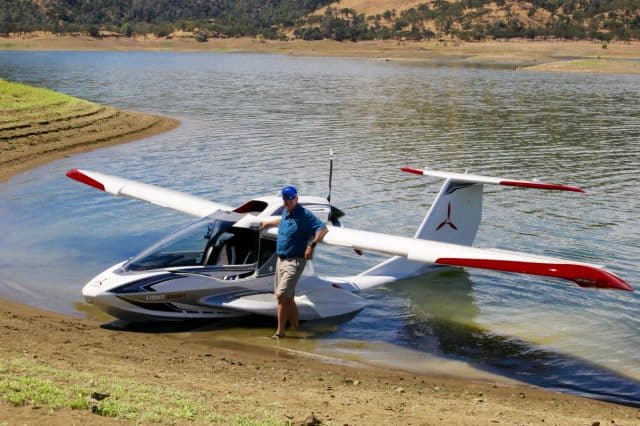
Rich Beaching at Eagle Island – A5
On an earlier blog I wrote about obtaining my Commercial Seaplane Rating in Alaska, you may have read how much fun it is to fly a floatplane (seaplane rating per the FAA). I had a blast flying the Pacer and Super Cub on floats – splashing around on lakes in Alaska. Recently, again in Alaska, I had the opportunity to experience a ride in a 1942 Grumman Goose amphibian (only 17 left in the world) and Lake Renegade amphibian, as well as fly a Cessna 180 on floats.
ICON Aircraft offered me the opportunity to be one of the first pilots to participate in their new training program and fly their amazing Light Sport Seaplane amphibian – the ICON A5. I have a deposit on a future A5, however my particular aircraft probably won’t be available for a few years.
The ICON A5 is in a relatively new class of Light Sport aircraft, which opens an incredibly wide range of opportunities for pilots; Sport Pilots and Private/Commercial Pilots alike. Officially it is a Light Sport Aircraft-Single Engine Sea (LSA-ASES). While there have been other great LSA-ASES on the market, this one has probably garnered the most interest recently.
I won’t go into the full details of the FAA Sport Pilot license (SPL) in this blog (more details at AOPA or EAA), however basically it allows a faster method to obtain a pilot’s license. In as little at 20 hours (most people require more time) you can obtain a Sport Pilot License to fly an airplane, lighter-than-air (balloon), weight-shift, or gyroplane depending upon your training. Training for a floatplane rating, will take some additional flight and instruction time.
With a Sport Pilot license there are some limitations in comparison to Private Pilot license (PPL). You are limited in the size of the aircraft you can fly, where you can fly, when you can fly (no night and high altitude flying), and can only take one passenger. Even with these limitations, it is a great avenue to obtain a pilot’s license and have a lot of fun, and you can always progress to the less-limited Private Pilot’s License later! One of the nice aspects of a Light Sport aircraft, is you can also use it for training for a Private Pilot’s license, usually at a lower cost.
If you already have a Private Pilot’s license, you can fly any Light Sport Aircraft that matches your category and class (e.g. single engine airplane land). In order to add a Sport Pilot additional aircraft category and class (e.g. single engine seaplane) to your PPL you follow the Sport Pilot additional rating process. Upon completion of the SP training you take a Proficiency Check – rather than a Practical Test. The Proficiency Check is very similar to the Practical Test except it is administered by a CFI. You can also use a Light Sport aircraft, like the A5, to add a full rating to your Private or Commercial Pilot’s license which would then require a check ride with a Designated Pilot Examiner (DPE), similar to the SPL Proficiency Check. It may seem a bit confusing at first, especially since you have so many options, however the process is fairly easy.
The Aircraft
The ICON A5’s primary structure is carbon-fiber for strength and light weight. Weighing in at a max gross weight of 1510 lbs., it has a maximum useful load of 500 lbs and fuel capacity of 20 gallons (100LL or Unleaded 91 Octane automobile fuel). Powered by a very smooth Rotax 912iSc, fuel injected engine, running a propeller at a maximum 5800 RPM (4800-5000 RPM in cruise), producing 100 HP. With a fully digital Engine Control Unit (ECU), it provides a modern way to power an aircraft, with automatic ignition and fuel/air management. This is definitely the way to power piston aircraft.
A5 N184BA – one of my aircraft for training at KVCB
All light sport aircraft have a gross weight restriction; in the case of LSA-SES it is 1430. ICON was able to convince the FAA to allow them a higher gross weight due to some great aircraft design features, including a parachute system, the Complete Aircraft Parachute (CAP) provided by BRS – similar to the one in my Cirrus SR22. The ICON A5 CAP is very unique, when you deploy the parachute an interconnect also lowers the landing gear to further soften your emergency landing.
The Numbers – A5 Specs at a Glance
- Gross Weight 1510
- Useful Load 500
- Baggage 60 lbs.
- Fuel capacity 20 gal
- Wingspan 34.8 ft – folded 7.8 ft.
- Length 23.0 ft
- Draft 14-23 inches (depending upon gear position – yes gear position !)
- Vso – 39 KCAS Vs – 45 KCAS
- Vfe – 75KCAS , Vle –KCAS, Vo 76 KCAS, Vne 120 KCAS
- Vwr – 10 KIAS (my definition – max speed for Water Rudder extension)
- Vwv – 1 ft (my definition – max wave height for operation)
Powerplant
The A5 uses the Rotax 912iS engine, coupled with a Sensenich 3-blade composite propeller. Since it is a pusher configuration, it avoids some of the damaging water spray while on the water and offers the pilot and passenger an unobstructed view. While the engine is mounted high on the fuselage, the pre-flight checks are easy (more on that later). Cooling is also optimized – as long as you don’t leave the canopy fully open after engine start ,which may impede the air flow. Checking oil is also very simple, just step on the seawing and check the quantity on top of the engine. Since it is both air and water cooled, you check the coolant level at the rear of the engine during preflight.

A5 Rear View of ROTAX Engine – Canopy would be closed or in the trailing position with the engine operating
Electrical System
This is an electric airplane, utilizing a 12-volt battery charged by 2 alternators. The Engine Control Unit (ECU) utilizes two channels (Rotax calls them ‘lanes’). The primary alternator for the ECU is actually the smaller 16-amp unit. The 30-amp alternator powers the avionics, battery, and provides backup power to the ECU. Since the ignition system is fully electronic, similar to a car, the two alternators are needed for redundancy. The plane makes extensive use of LEDs for lighting, as expected, providing a good internal lighting environment and excellent position and taxi/landing lights.
A5 LED Position Light – Needed as a plane and a boat!
Fuel System
The A5 uses a single, fuselage-mounted, fuel tank, with an amazingly accurate self-calibrating fuel indicating system. You only have to put the fuel selector in the ‘ON’ position in flight. The airplane incorporates 2 engine-driven fuel pumps, again for redundancy. The engine utilizes premium autogas (MOGAS) or 100 LL – the advantage of longer oil change intervals, etc. with the autogas. Another clever ICON design is solving the issue of checking for fuel contamination. Sampling fuel on a land plane can be a nuisance, on a float plane it is a major pain, trying to balance yourself on a float – hanging out over the water to reach a wing sump or balancing between the floats in the front for the engine sump. ICON’s design is downright simple. They incorporated a tube inside the fuel neck that reaches to the bottom of the fuel tank. The pilot inserts a syringe that connects with that tube and you draw a fuel sample up for examination – nothing could be easier!
ICON A5 Fuel Neck – Note the small tube on the left where you attach a syringe
Gear System
In land retractable aircraft you utilize a squat switch to prevent gear retraction on the ground, not in an amphibian! Since you can extend and retract the gear in the water, without a weight-on-wheels sensor to prevent accidental retraction, you need to be careful at all times. A simple task if you use the checklist – every time.
The gear system is simple, which is great, featuring a fully castering nose wheel , with a two position switch – UP for Water, DOWN for LAND. As with all amphibians, you recite a full gear check item on your checklist – “Gear down for Runway – indicating down” and “Gear Up for Water – indicating Up”. Similar to the usual GUMP check, but even more important since your landing surface changes frequently. The A5 main gear will probably not retract if accidentally raised while on land, however the nose gear would. I don’t want to be the pilot to test this theory
Cockpit
ICON A5 Cockpit – all switches in easy reach
As a Computer Science Professor and techie, I love technology in airplanes. There are a number of great LSAs and other aircraft with powerful glass panels featuring integrated MFD (Multi-Function Display) with EIS (Engine Indicating Systems) and PFD (Primary Flight Display) implementations. I enjoy flying and teaching in them, however the ICON A5’s design offers a very efficient implementation for its mission. At 6′ 3″ I found the 46″ wide cockpit quite comfortable, even after 2 hour flights. The cabin height is great, however our son is 6’7″ and for him it is a bit tighter especially the legroom. The ICON staff mentioned that they aimed for the 95 percentile in fit, which makes sense, however 97% would be even better for our son 🙂 On the other hand it fits me perfectly!
Flight Instruments
After flying over 80 aircraft makes/models, from taildraggers and gliders to helicopters and modern jets, it is wonderful to slip into the cockpit of the A5 and experience a well designed and ergonomic cockpit. The ICON folks designed a cockpit environment that is intuitive the minute you sit in the pilot’s seat. With the instrumentation conveniently arrayed in front of you with easy to read analog displays, it just seems right!
The Angle of Attack (AOA) indicator sits prominently at the top. ICON positioned the AOA at the top for a reason – you reference it during all phases of flight and it is an important instrument for landings.
The A5 utilizes a Garmin 796 GPS, which is removable, as the navigation system with XM capability and communicates with the single Trig COM. The A5s I flew have a Trig Mode-S Transponder and future production models will have an ES – extended squitter unit for ADS-B out and possibly ADS-B in.
After owning, and flying, a number of aircraft my only suggestion would be the addition of a volt/ammeter so you can see the actually battery voltage before start to check the health of the battery and charging rate and voltage during flight. I mentioned this to the ICON folks, as a suggestion for the future. Alternatively, you could use a 12v meter in the accessory receptacle in the center console, which is next to 2 USB power ports.
ICON A5 Instrumental Panel – AOA at top
You can see some additions over land planes- the addition of a Purge Bilge annunciator – important when water gets into the airplane structure during normal water operations. Since the wings fold a warning light informs you if the wings or stabilizer tips are not secure. In addition they have a LAND AIRCRAFT light which indicates you may have an impending engine issue and it is in your best interest to get on the ground — or water as soon as possible! ICON is changing the altimeter design, so future aircraft will look slightly different.
You don’t need an Exhaust Gas Temperature (EGT) gauge since the ECU takes all of the work of setting the correct mixture, which optimizes the engine and makes flying that much easier.
Folding the Wings
One of the very cool features of the A5, are the folding wings. Utilizing this system you can change the width of the A5 from 35 ft to 7.8 ft, in a matter of seconds. We did it in 15 seconds. The wings fold, and unfold, easily by activating levers under each wing. In order to maintain integrity and greatly reduce pilot effort, the ailerons automatically align when the wings are unfolded back into flying position.
Folding the wing on the ICON A5 from Personal Wings on Vimeo.
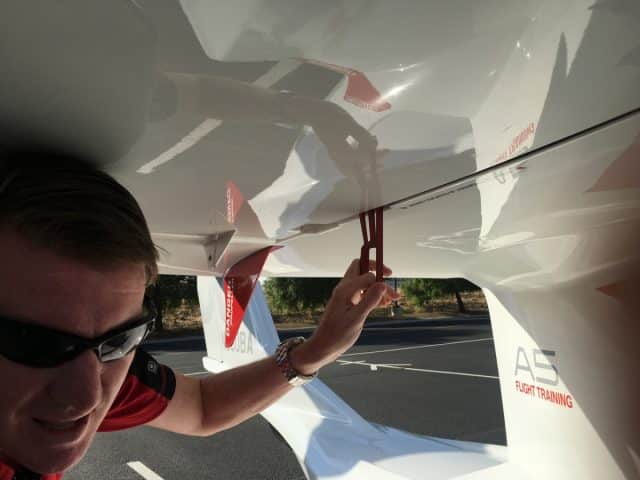
Shane ‘Sully’ Sullivan demonstrating releasing the wing folding lever on the A5
Then wings are then pulled slightly out and rotated back into the stowed position.
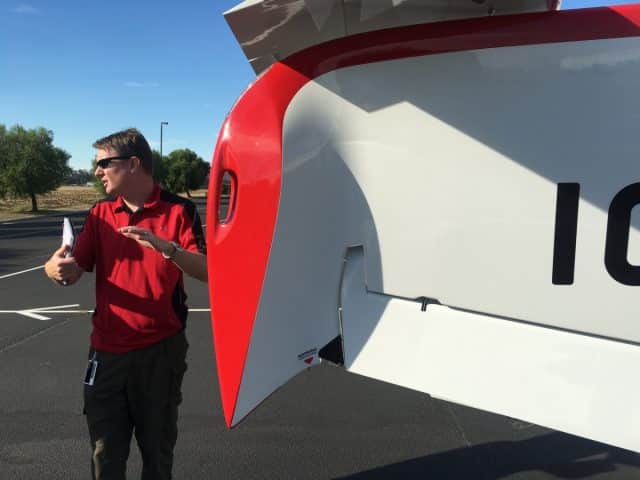
A5 Wing in Folded – Stowed Position
ICON A5 Wing Folding Mechanism – You can see the wing locking levers in their unlocked position
Next you need to remove the horizontal stabilizer tips to minimize the width for trailering. Simply turn the lever under the stabilizer and voila – the tips are removed! The bird is now ready for easy storage or transport to another lake, or airport, or both!
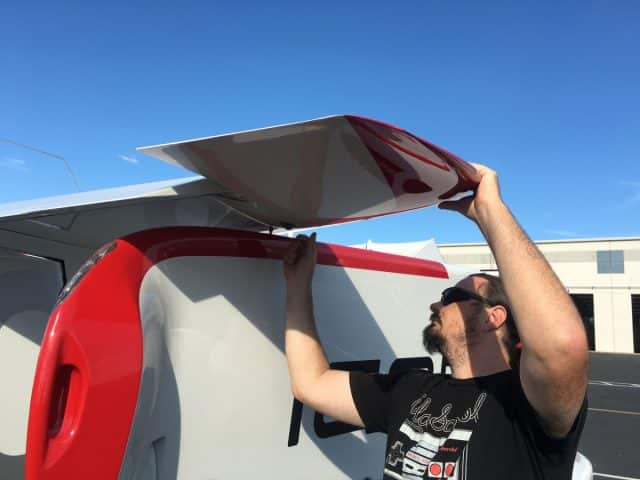
Jay removing the stabilzer tips on the A5
The Course
To say I was excited about learning another airplane, especially the A5, would be an understatement. To me, flying is always about learning and gaining knowledge since my first license in 1977. I couldn’t wait to get my hands on the A5 training materials.
ICON is offering several training programs including; Initial LSA-Land and Sea, Private Pilot Land transition to LSA-SES, and Private Pilot Sea A5 transition. Since I already had my Commercial Single Engine Sea I chose the later course. In some ways I was bummed, since I wanted to fly the airplane more hours!
Wendi Hauger of ICON scheduled my training and sent my training materials by email and FEDEX. The materials arrived shortly and I couldn’t wait to read them. Despite already having my ratings, and far amount of experience in 10,000 hours of flying, I read all of the materials to get an idea of their full program.
The materials are simply some of the best I’ve seen for initial and transitioning pilots. The course books includes: Sport Flying Academics, Sport Flying Operations, Flight Training Course Guide, and Sport Flying Supplement.
ICON is also developing an online course to supplement the information and help with pre-assessment before arriving at their training facilities.
ICON A5 Course Materials
The Sport Flying Academics manual does a great job of educating non-pilots on the various areas of flight. Their discussion, and course flow, on aerodynamics provides a very fluid progression from a simple discussion of why the study is important to encompass all of the information a Light Sport pilot would need, or for that matter at Private Pilot. Their approach, which initially appeared too simplistic to me, began to make more sense as I progressed through the book. As a CFI I would prefer a bit more information on flying into controlled airspace in this manual, however this is covered in a separate Controlled Airspace Endorsement (CAE) Course. In 193 pages, they cover a large amount of essential information.
Sport Flying Operations. In addition to expanding on a number of topics from the Sport Flying Academics manual, ICON starts the application of many of these topics to flying the A5. They expand the training emphasis to discuss land and sea operation of the A5. Water operations are inherently more difficult due to all of the different environmental factors (water condition, winds, floating debris, beaches, docks, etc.) which is reflected in the 40 pages on water ops and a much shorter section on landing on runways. The other topics include navigation, weather, hazards, and a great selection of references on items ranging from the FARs to abbreviations. I particularly liked the weather section (maybe since I once worked as an ABC Weathercaster in Oregon) since it takes a large amount of information and presents it in a very understandable format that is useful for Light Sport and Private pilots.
Sport Flying Supplement. If you were wondering how to tie knots, or always wanted to know the full mathematical formula for range as it relates to propeller efficiency and L/D, this is the book for you! It also offers a detailed look at Angle of Attack (AOA) and its relationship to many performance factors.
Flight Training Course Guide. This guide provides the outlines for several training options: Initial Sport Pilot Single Engine Land and Sea, Transition Seaplane Rating for Sport and Private Pilots with existing Landplane certification, and Transition-Seaplane for pilots that already have the Land and Seaplane ratings are want to learn to fly the A5. The guide discusses the pre-arrival academics as well as a syllabus for each lesson, clearly listed in each section.
Location, Location, Location
The first, and currently one, training center is at ICON’s headquarters at the Nut Tree Airport (KVCB) in Vacaville California, near Lake Berryessa which is used for the water training. ICON is planning additional training centers as their company, and the demand, grows. The next training center will be in the Tampa Florida area, with others to follow. KVCB is also where the ICON A5 is being assembled.
I flew up from Montgomery Field (KMYF) under VFR conditions in a friend’s Piper Mirage that I borrowed for the trip. The flight was only a bit over 2 hours in smooth skies at 16,500 ft. Of course, I had to bring one of my bikes along for local transportation.
Mirage Silver Fox at VCB for ICON A5 Training
Dawn Arrives at ICON
I arrived early in the morning on my bike before my instructor and had a chance to checkout the planes. The line staff were getting the planes ready for training. They did a great job of ensuring all of the aircraft were fueled and ready. They also were very helpful answering my constant questioning about the aircraft and the systems.
Gaggle of ICON A5s Early Morning at KVCB
Classroom
The ICON Flight Center has a very good training facility with classroom and briefing rooms. After registering with Ariel Andrus, I was paired up with Shane ‘Sully’ Sullivan, a former Navy F/A-18 and P-3 pilot. My classmate was a Private Pilot without a seaplane rating, so after an introductory session we split off for my transition training. ICON describes their ground sessions as ‘Ground Labs’ and the information was presented in a very interactive method. For me it was focused on the characteristics of an LSA and the A5 in particular. Since I had reviewed all of the material prior to class, the process went very quickly.
Since this is a Light Sport Aircraft, one thing to remember is the keyword ‘light’. It responds differently to high winds and the control forces are lighter than most General Aviation aircraft. I found that not to be an issue, but always reminded myself that crosswind landings might be slightly more challenging, however its maximum demonstrated crosswind (an FAA definition) is the same as a Cessna 172. In flight I found it to be an extremely responsive aircraft, you just need to adjust to its characteristics just as with any other aircraft.
Preflight
ICON A5 – starting preflight inspection
My airplane for the day was the first production A5 which was generously donated to the EAA and temporarily is used on the ICON training fleet. The preflight inspection is straight forward for an amphibian! As with all aircraft you check the general condition. Since we have folding wings and removable stabilizer tips, you have some additional inspections as noted above by ensuring the wing release handles are secure and the stabilizer tips secured. The cockpit also has an annunciator in case these flying surfaces are not locked. The seawing (horizontal surface on the fuselage) makes it easy to step up and check the air intake and oil level.
ICON A5 Nose Gear inspection – note the gear fairing is also the lower surface for beaching
Cockpit windows on the ICON A5 – easily installed in seconds
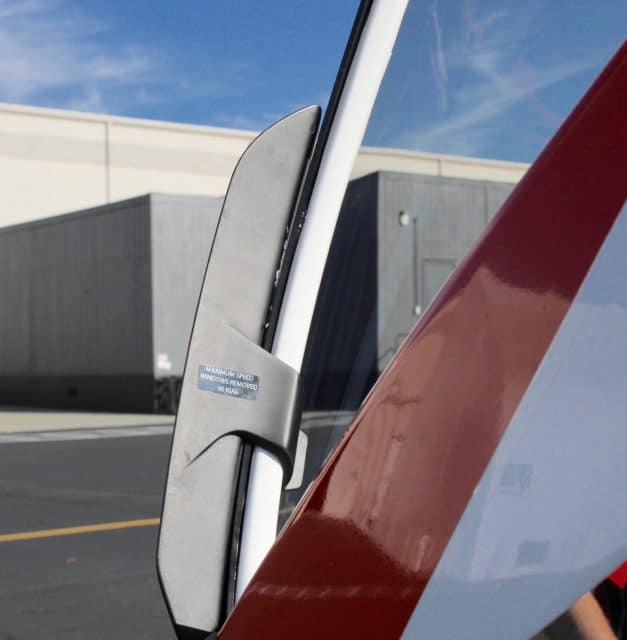
With the windows out – and deflectors installed – limited to 90 KIAS but very cool to fly without windows!
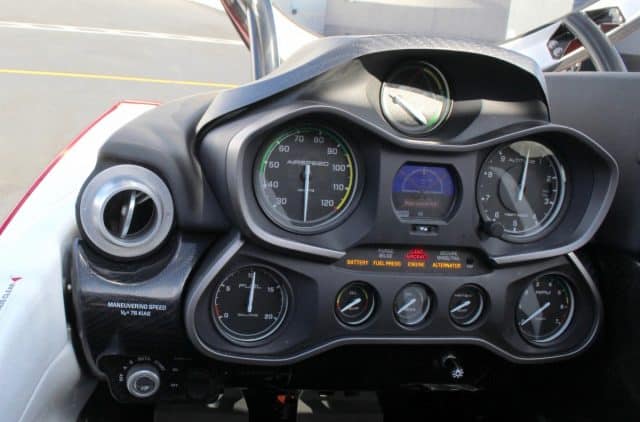
A5 Preflight Cockpit – master switch in lower left of knee panel
A5 Preflight Cockpit – parachute is secured by pin before flight and electrical panel with CBs and fuses. Fuel valve aft of parachute handle
ICON A5 Wing Folding Levers Stowed – we also check the security at the wing tip and stabilizer tip security
ICON A5 Water Rudder – check for security and ability to manually push up – You don’t see this on your typical Cessna!
Up, Up, and Splash – Time to Get Wet!
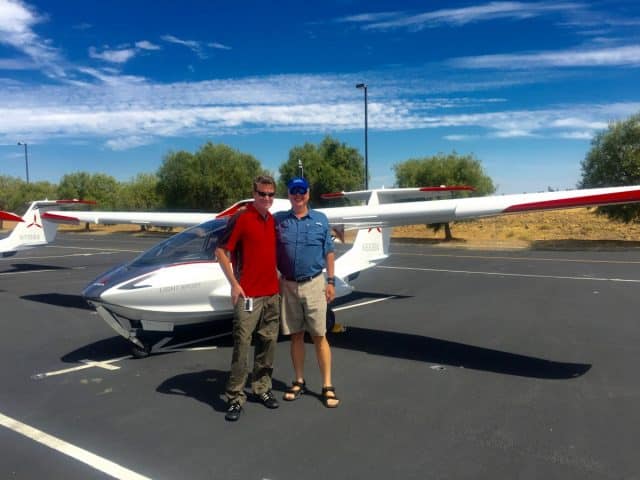
Sully and Rich about to fly the A5
Starting couldn’t be easier. After doing our cockpit check (securing belts, brakes, CAP pin removed, etc.) you simply turn the master on and move the ignition to ‘Lane A’ wait 6 seconds while the ECU performs tests, then do the same on ‘Lane B’, turn to both and start. The Rotax starts easily – every time hot or cold. I increased the RPM to 2500 to excite the alternator and do a few checks, then off to the runup area. At the runup area you check the ignition system, similar to a mag check on legacy engines, verify everything is operational and proceed to the runway.
Takeoff
The A5 literally leaps off the runway in a short distance when I rotated at 50KIAS with flaps up. Gear retraction, and extension, is 75KIAS so relatively quickly the gear was up after clearing obstacles. I climbed at Vy (best rate of climb) – 60 KIAS, with initial rate of climb (ROC) of 500+ FPM. To be the most efficient you fly by AOA – white line for Vy. The plane is a dream to fly!
ICON A5 Climbing Vy White Line AOA
Stalls – or Not?
On the way to Lake Berryessa I flew in slow flight (minimum speed just above a stall) and performed the stall series. This plane is so docile in the aerodynamic stalls, maintaining aileron control throughout the maneuver, that is is hard to call these the typical stalls you might see in other airplanes. In most airplanes you have a relatively abrupt aerodynamic effect when stalling an airplane. The aileron control in the A5 is similar to the Cirrus, you can effectively use them safely through the stall. Through the series of stalls, I lost a maximum of 50 feet unless I purposely held onto the stall. The departure, power-on, stall had a buffet but I was still climbing almost 100FPM! The stalls are so gentle that if this is your first airplane flight you might think all airplanes stall like the A5! I enjoyed then so much I always did some on our way to the lake, but then as my students know I always love stalls 🙂
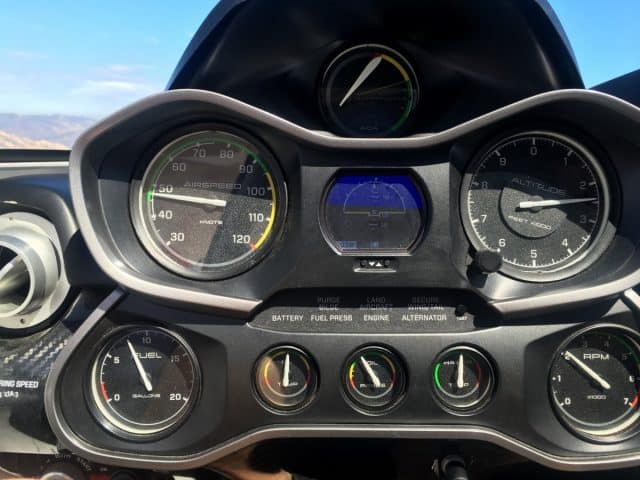
A5 – slow flight approaching clean Stall – note AOA just above redline and IAS approaching a stall of 45 KIAS
Time to Splash!
Just to the north of Vacaville is the lake, with the dam on the east side. On the first day, I flew over the dam and headed for the main portion of the lake. Since you have so much flexibility to land on lakes and the ‘runways’ are not marked obviously, and you share the water with other watercraft it is very important to stay vigilant. Descending to the lake, I take care to look for power lines, especially since this is a hydroelectric dam, that extend across the hill tops surrounding the lake.
Angle of Attack – The ICON A5 AOA Indicator
Since the best way to operate an aircraft is by flying the optimum Angle of Attack for a particular maneuver the only accurate way to determine it is to use an AOA indicator. ICON uses an intuitive approach – with basically three references – on green line, on white (dashed) line and yellow line. As your speed increases the indicator progresses towards the top of the green – which is high speed cruise. The red line represents the stall mentioned above. Since AOA for a particular maneuver should be always the same degree, however the Indicated Airspeed (IAS) will change depending upon weight, flap configuration and G-loading using the AOA indicator is preferred. This is the same reason turbine and military pilots rely on AOA.
ICON AOA Indicator
Landings
I don’t know what can be more fun, flying at least, than landing on water and the A5 definitely seems like a duck in the water!
Approaching the water it is time to do the pre-landing checklist. 1) Gear UP for Water, indicating up 2) Flaps 30 degrees, 3) Water Rudder UP. I always like to repeat the Gear check, 3 times, on downwind, base leg, and final — just in case !
Using the AOA indicator for water landings is so cool! In the A5 you simply start your approach at an AOA on the ‘On-angle white line’ and keep that value until on short final.
As you slow down for landing just a few feet above the water you slow down to an AOA in the middle of the yellow, which is approximately 1.3 times the stall speed with the flaps extended. You can also land a bit faster if you are landing on a glassy surface. In the video you will see how smoothly you can land on the water, in this case we were practicing on ‘glassy’ water which can be more challenging since you may not have adequate references for height above the water.
Beaching
Okay you are flying into a lake and now you want to get on land. You can use a dock, drive up a boat ramp, or what is really fun is to park on a beach! On my first beaching, we chose Eagle Island – aptly named due to some eagles nearby.
From the air it is difficult to determine the true condition of any runway – land or water. With water landings it may be more difficult since there may be submerged sandbars, tree stumps, and rocks. Beaching can be an even bigger challenge. The first order of business is to evaluate the landing area, then taxi by the beach after landing for a closer look, followed by a slow taxi towards the beach.

Rich Beaching at Eagle Island – A5
On Day 2 of the Transition Training, my second CFI – Mike Turner, and I decided to practice a confined area landing on the way to the same beach. Approaching the landing area, I was a bit slower than usual flying the AOA at the top of the yellow on base leg, then half way in the yellow for landing. After landing, you can see a high speed, or step, taxi to the island, then a turn to survey the area. As we approached the beach I shutdown the engine, removed headsets and seatbelts and prepared to get wet.
This time I beached on the point and made it easy for Mike to step out on dry land – for a change. The things I do for my flight instructor 🙂
ICON A5 Beaching at Eagle Island – Day 2
As you probably noticed on the video, when you stop on the water – water comes over the bow into the air vent as you decelerate, on your feet, then into the bilge. The A5 has a water sensor, and when it illuminated, I simply turned on the bilge pump!
ICON A5 Purge Bilge Light
On the way out, I snapped a photo of one of my classmates, Burt, departing the island.
ICON A5 Leaving Eagle Island
Since the A5 sits low in the water, you need to be careful when beaching on sloping surfaces or at docks. To explore steeper beaches, we tried another island to experiment. As you can see you have to be careful when using these beaches to avoid damage to the wing tip, or changing tides and water levels.
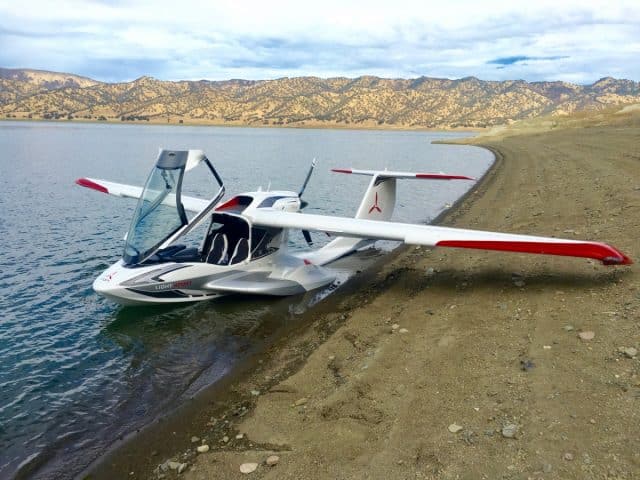
Beaching the A5 on a slope – note how close the wingtip is to the beach.
Cruising!
Lake Berryessa is a great place to cruise, especially over the water in the A5. One of the rivers that feed the lake is Putah Creek. We dropped down and followed the creek back to the lake for more fun!
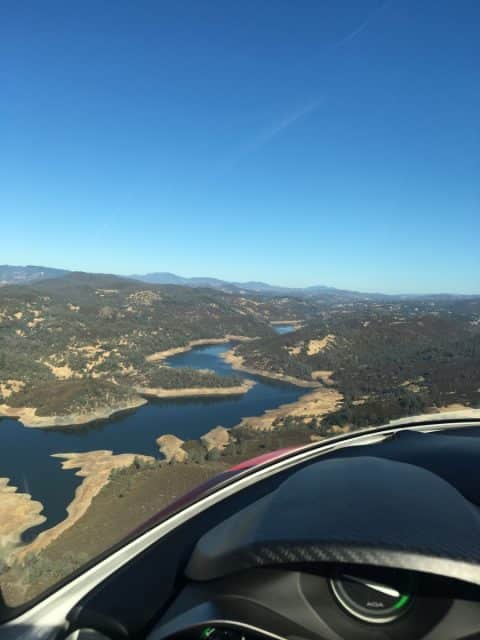
Flying along the Putah Creek
Emergencies!
Call me crazy, but I love practicing emergencies. In 40 years of flying, I’ve had a few real ones and the best way to prepare is to practice frequently
On the way to the lake on another flight from Vacaville, I did an emergency descent, reducing the power to idle and gliding at white line on the AOA all the way to the water. With a glide ratio of 9:1, the A5 glided effortlessly, and I kept my intended landing spot in the same sight picture. Close to the water, I extended my flaps to 30 degrees, continued to slow to an AOA of mid-yellow for a smooth landing on the water. After landing, I increased power to do a Step Taxi at 30 kts under the power lines suspended over the lake and then transitioned back to a take off.
As you can see in the video, the plane glides very well with the AOA stable on the white line, with a pitch of between 9 and 11 degrees from an elevation of 3300 MSL (feet above Mean Sea Level) to the water surface at 440 MSL. Again a great example of using the AOA.
Simulated engine failures after takeoff, etc. were equally as simple. As long as the pilot monitors the AOA, it is an easy process to consistently make a safe landing.
Landing on Runways
This will be brief, mainly since I had so much fun on the water I didn’t want to spend much time on the runways. The A5 is very simple to land, as long as you use the AOA and fly stabilized approaches you can consistently land the plane exactly where you want. Of course, you always want to follow the checklist – especially ‘Gear DOWN for Runway – Indicating down’. Whether you use flaps, or not, the A5 doesn’t use much runway and the pitch attitude is similar to my SR22 – just about 5 degrees nose up on touchdown.
Over Too Soon
It seemed my two day transition course was way too short, in fact we added an extra 2 hours just to have more fun before heading back to San Diego. Flying floatplanes is such a kick, and flying the amphibious ICON A5 has to rank up near the top of my flying experiences. It isn’t a fast cross county airplane, can’t carry a large load of people or baggage, and may have other limitations but that isn’t why you own or fly an ICON A5. You fly an ICON A5 to have fun flying, on land or water, and have experiences that are only available with a handful of airplanes. The design, quality, and shear pleasure of flying the aircraft left me with a big smile on my face, and a desire to fly it again!
If you’d like to learn how to perfect your flying skills, contact me to schedule an instruction flight. Don’t forget your sandals!

Thoroughly enjoyed the read. Excellent write up! Thanks for sharing!
Thanks Jason – I’m glad you enjoyed it!
Agreed !!!!
Rich, this is a very useful write up. I also thoroughly enjoyed the read and videos. I had the opportunity a few years back to try out the A5 simulator at ICON”s old headquarters in LA. It was a very unique and exciting experience. Having watched the company develop from its early days and the team’s learning from the challenges faced by Eclipse in overreaching on the technology innovation curve, its great to see the aircraft go into production, with the company delivering on its original vision. Looking forward to a demo ride, hopefully soon.
Please add me to your email lists for new postings. Thanks! M.
Mike – I will let your know! Rich
Excellent write up and review Rich! I feel like I got to fly along with you. Sounds like Icon did their UX/UI homework. Such a cool vehicle.
Sandals ready,
Ross
ps. Say hi to that tall son of yours for me 🙂
Hi Ross- thanks for the comments and I’ll say hi to Tigre!
Rich,
What an amazing plane! I enjoyed your review. Very well written. Looking forward to your next post.
Hello from Sydney A5 position holder Darren best report on the A5 yet more info than anywhere even better than ICON with true vids not hype well done Rich. Hope they get their production sorted and get aircraft to customers soon its been a long wait but after your report and vids I think its worth it.
Darren – Thanks for your comments, I try to give objective information. For this blog, one of my longest, I wanted to provide more detail about the airplane – which is amazing. I hope to add additional ICON information this fall, and will let you know when it is updated. I have additional videos flying the A5 and will load them. I also have friends in Australia and it would be good to see an A5 down there!
Thanks again for visiting my site, and you might find some of my othe blogs useful. Cheers, Rich
Awesome site and blog about the A5. Enjoyed it all. Please put me on your list. Cheers, Chuck
Thanks, Chuck! Appreciate the support!
Great writeup. I’ve been having a ton of fun flying it in MSFS. This article helped me figure out the AOA gauge.